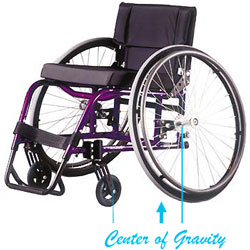Wheelchair Center of Gravity

Center of gravity is probably the most important adjustment that you can make to a wheelchair to maximize its performance. When the center of gravity is changed, the combined wheelchair and user weight moves forward or backward on the wheelchair frame in relation to the wheels and casters.
When too much weight is loaded on the casters they will tend to roll less easily and make their swivelling more difficult due to the stresses put on the bearings. This is especially an issue on soft terrains such as lawns because the casters will not normally roll or swivel easily anyway.
In order to make this adjustment the wheelchair must have either a movable axle bar or adjustable axle plate. This is a feature of most of the mid-range and high-end wheelchairs only but well worth the extra cost.
The lower end wheelchairs have fixed rear wheel positions that are determined by the manufacturer in their design. They opt for a center of gravity that is further forward because they are more concerned with the safety than wheelchair efficiency on their lower priced wheelchairs.
Changing the center of gravity is as simple as moving the rear wheels forward and backward on the wheelchair frame.
By moving the wheels backward on the frame more weight is loaded onto the front casters because the weight is centered between the casters and rear wheels. As the wheels are adjusted further and further backwards the center of gravity of the wheelchair moves forward and the amount weight loaded on the casters increases.
When moving the rear wheels forward on the wheelchair frame the center of gravity is moving backwards in relation to the position of the wheels and casters which takes more and more weight off the casters allowing them to roll and swivel more easily.
The downside of having the center of gravity moved backwards is that the chair is more likely to tip over backwards if the user is self-propelling the chair vigorously or climbing hills and ramps. The further back the center of gravity the tippier the wheelchair.
Because there is a downside to having the center of gravity too far forward (caster loading) and too far backward (backward tipping) it's important to get the adjustment as close to ideal as possible.
"Ideal" will vary between users and some experience in needed to get the adjustment right. Users differ in weight, height and strength and all these factors play into adjusting the center of gravity.
Often there is some trial and error involved where a user will have to use a their chair at a certain setting for a while before knowing if the setting is right for them. They may find that after using their chair for a few days in the real world that they would prefer the center of gravity be moved a little bit forward or backward to better balance efficiency with safety.
Wheelchairs where the center of gravity is adjustable are usually designed for active users such as teens and adults who are out in the world on a daily basis. But the center of gravity, set up properly, on a wheelchair can make the propulsion of a manual wheelchair much easier for seniors who spend most of their time in retirement homes or other types of institutions.


 Online Vendors
Online Vendors  US Online Vendors
US Online Vendors 
